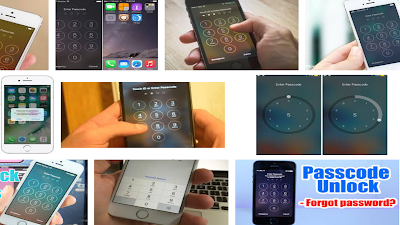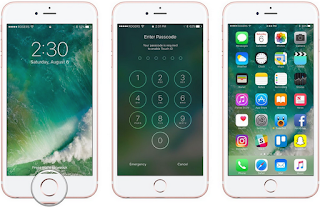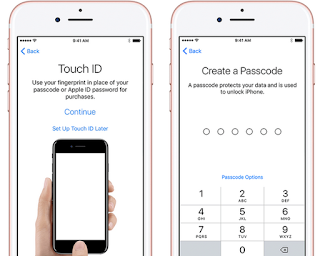iPhone Passcode Setup
Turn on iPhone, then follow the Setup Assistant on your new iPhone model. The Setup Assistant steps you through the process, including:- Connecting to a Wi-Fi network
- Signing in with or creating a free Apple ID (needed for many features, including iCloud, FaceTime, the iTunes Store, the App Store, and more)
- Entering a passcode
- Setting up iCloud and iCloud Keychain
- Turning on recommended features such as Location Services
- Adding a credit or debit card to Passbook to use with Apple Pay (iPhone 6 or iPhone 6 Plus)
- Activating iPhone with your carrier
iPhone Passcode
The iPhone passcode need when you turn iPhone on and unlock it the first time. You’ll also be asked for your Apple ID password for the first purchase you make in the iTunes Store, App Store, or iBooks Store.
Use the Touch ID sensor to make a payment in the iTunes Store, App Store, or iBooks Store. When purchasing from the iTunes Store, App Store, or iBooks Store, follow the prompts to enable purchases with your fingerprint. Or go to Settings > Touch ID & Passcode, then turn on iTunes & App Store.
Use Touch ID for Apple Pay. (iPhone 11 or iPhone 11 Pro Max) Go to Settings > Touch ID & Passcode to ensure that Apple Pay is enabled with your Touch ID.
Delete a fingerprint. Tap the fingerprint, then tap Delete Fingerprint. If you have more than one fingerprint, place a finger on the Home button to find out which fingerprint it is.
Name a fingerprint. Tap the fingerprint, then enter a name, such as Thumb.
iPhone Security
Security features help protect the information on your iPhone from being accessed by others.
Use a passcode with data protection For better security, you can set a passcode that must be entered each time you turn on or wake up iPhone.
How to Set Up iPhone passcode?
Here the iPhone guide to setup iPhone passcode:
- Go to Settings > Touch ID & Passcode (iPhone models with Touch ID) or
- Go to Settings > Passcode (other models), then set a 4-digit passcode.
How do you unlock a disabled iPhone?
Unlock Disabled iPhone/iPad/iPod without iTunes through Find My iPhone
- Go to icloud.com, find from another device or computer.
- If prompted, sign in with iCloud Apple ID.
- Click All Devices at the top browse window.
- Select device which you want to erase.
How do I get into my iPhone if its disabled?
The device should turn on, then:
- Continue holding the Home button until you see the Connect to iTunes screen. iTunes will alert you that it has detected a device in recovery mode. Click OK, and then restore the device.
You can reset an iPhone without the password by follow this iPhone manual insctructions:
- Press and hold the Home button (at the bottom of iPhone) and the Sleep/Wake button (on top of the iPhone) simultaneously.
- Hold both buttons until the iPhone shuts off and begins to restart.
- Let it go when you see the Apple logo appear on screen.
This tutorial also resolve:
- How to unlock iphone passcode without computer
- How to unlock iphone XR passcode without itunes
- Forgot iphone passcode without restore
- Forgot iphone 11 passcode
- I forgot my iphone passcode
- Hack iphone passcode
- How to unlock a disabled iphone
Turn off Simple Passcode and use a longer passcode. To enter a passcode that’s a combination of numbers and letters, you use the keyboard. If you prefer to unlock iPhone using the numeric keypad, set up a longer passcode using numbers only.
Add fingerprints and set options for the Touch ID sensor. (iPhone models with Touch ID) Go to Settings > Touch ID & Passcode.
Allow access to features when iPhone is locked. Go to Settings > Touch ID & Passcode (iPhone models with Touch ID) or Settings > Passcode (other models). Optional features include:
- Today
- Notifications View
- Siri
- Passbook
- Reply with Message
Erase data after ten failed passcode attempts
Go to Settings > Touch ID & Passcode (iPhone models with Touch ID) or Settings > Passcode (other models), then tap Erase Data. After ten failed passcode attempts, all settings are reset, and all your information and media are erased by removing the encryption key to the data.
If you forget your passcode, you must restore the iPhone software.
On iPhone models with Touch ID, you can unlock iPhone by placing a finger on the Home button. Touch ID also lets you:
- Use your Apple ID password to make purchases in the iTunes Store, App Store, or iBooks Store
- Present your credit card or debit card when making a purchase in a store that offers Apple Pay as a method of payment
- Provide debit and credit card info, billing and shipping addresses, and contact info when paying in an app that offers Apple Pay as a method of payment
Set up the Touch ID sensor.
Go to Settings > Touch ID & Passcode. Set whether you want to use a fingerprint to unlock iPhone, and to make purchases. Tap Add a Fingerprint, then follow the onscreen instructions. You can add more than one fingerprint (your thumb and forefinger, for example, or one for your spouse).
iCloud Keychain
iCloud Keychain keeps your Safari website user names and passwords, credit card information, and Wi-Fi network information up to date. iCloud Keychain works on all your approved devices (iOS 7 or later) and Mac computers (OS X Mavericks or later).
iCloud Keychain works with Safari Password Generator and AutoFill. When you’re setting up a new account, Safari Password Generator suggests unique, hard-to-guess passwords. You can use AutoFill to have iPhone enter your user name and password info, making login easy. Some websites do not support AutoFill. iCloud Keychain is secured with 256-bit AES encryption during storage and transmission, and cannot be read by Apple.
Set up iCloud Keychain
Go to Settings > iCloud > Keychain. Turn on iCloud Keychain, then follow the onscreen instructions. If you set up iCloud Keychain on other devices, you need to approve use of iCloud Keychain from one of those devices, or use your iCloud Security Code.
If you forget your iCloud Security Code, you have to start over and set up your iCloud Keychain again.
Set up AutoFill. Go to Settings > Safari > Passwords & AutoFill. Make sure Names and Passwords, and Credit Cards, are turned on (they’re on by default). To add credit card info, tap Saved Credit Cards.
The security code for your credit card is not saved—you have to enter that manually.
To automatically fill in names, passwords, or credit card info on sites that support it, tap a text field, then tap AutoFill.
To protect your personal information, set a passcode if you turn on iCloud Keychain and AutoFill.
Limit Ad Tracking
Restrict or reset Ad Tracking. Go to Settings > Privacy > Advertising. Turn on Limit Ad Tracking to prevent apps from accessing your iPhone advertising identifier. For more information, tap About Advertising & Privacy.
Find My iPhone
Find My iPhone can help you locate and secure your iPhone using the free Find My iPhone app (available in the App Store) on another iPhone, iPad, or iPod touch, or using a Mac or PC web browser signed in to www.icloud.com/find. Find My iPhone includes Activation Lock, which is designed to prevent anyone else from using your iPhone if you ever lose it. Your Apple ID and password are required to turn off Find My iPhone or to erase and reactivate your iPhone.
Turn on Find My iPhone. Go to Settings > iCloud > Find My iPhone.
To use Find My iPhone features, Find My iPhone must be turned on before your iPhone is lost. iPhone must be able to connect to the Internet for you to locate and secure the device. iPhone sends its last location prior to the battery running out when Send Last Location in Settings is turned on.
Use Find My iPhone. Open the Find My iPhone app on an iOS device, or go to www.icloud.com/find on your computer. Sign in, then select your device.
- Play Sound: Play a sound at full volume for two minutes, even if the ringer is set to silent.
- Lost Mode: Immediately lock your missing iPhone with a passcode and send it a message displaying a contact number. iPhone tracks and reports its location, so you can see where it’s been when you check the Find My iPhone app. Lost Mode also suspends the use of your credit and debit cards used for Apple Pay (iPhone 11 and iPhone 11 Pr0; iPhone 11 Pro Max and iPhone XR).
- Erase iPhone: Protect your privacy by erasing all the information and media on your iPhone and restoring it to its original factory settings. Erase iPhone also removes the ability to make payments using your credit and debit cards used for Apple Pay (iPhone 11 and iPhone 11 Pro; iPhone X and iPhone 11 Pro Max).
Before selling, upgrade iPhone or giving away your iPhone, you should erase it completely to remove all of your personal data and turn off Find My iPhone to ensure the next owner can activate and
use the device normally. Go to Settings > General > Reset > Erase All Content and Settings.
Siri settings
To set options for Siri, go to Settings > General > Siri. Options include:
- Turning Siri on or off
- Turning Allow “Hey Siri” on or off
- Language
- Voice gender (may not be available in all areas)
- Voice feedback
- My Info card
Emergency calls
Make an emergency call when iPhone is locked. On the Enter Passcode screen, tap Emergency Call (to dial 911 in the U.S., for example).You can use iPhone to make an emergency call in many locations, provided that cellular service is available, but you should not rely on it for emergencies. Some cellular networks may not accept an emergency call from iPhone if iPhone is not activated, if iPhone is not compatible with or configured to operate on a particular cellular network, or (when applicable) if iPhone does not have a SIM card or if the SIM card is PIN-locked.
In the U.S., location information (if available) is provided to emergency service providers when you dial 911. Please review your carrier’s emergency calling information to understand the limits of emergency calling over Wi-Fi.
Change the language for Voice Control. By default, Voice Control expects you to speak voice
commands in the language that’s set for iPhone (in Settings > General > International >
Language).
To use Voice Control in another language or dialect, go to Settings > General >
International > Voice Control.
Voice Control for the Music app is always on, but you can keep Voice Control from dialing
when iPhone is locked. Go to Settings > Touch ID & Passcode (iPhone models with Touch ID) or
Settings > Passcode (other models), then turn off Voice Dial.
Choose whether to show Today and Notifications View on a locked screen. Go to Settings > Touch ID & Passcode (iPhone models with Touch ID) or Settings > Passcode (other models), then choose whether to allow access when locked. Close Notification Center. Swipe up, or press the Home button.
Restrictions
You can set restrictions for some apps, and for purchased content. For example, parents can restrict explicit music from appearing in playlists, or disallow changes to certain settings. Use restrictions to prevent the use of certain apps, the installation of new apps, or changes to accounts or the volume limit.
Turn on restrictions. Go to Settings > General > Restrictions, then tap Enable Restrictions. You’ll be asked to define a restrictions passcode that’s necessary to change the settings you make. This can be different from the passcode for unlocking iPhone.


